From Pompeii and Rome to Teotihuacan and beautiful Palmyra, ancient cities stand as remarkable testaments to the achievements of past civilizations, providing us with a window into the lives and societies of our ancestors.
These urban centers, built centuries ago, offer a treasure trove of historical and archaeological evidence that allows us to piece together the puzzle of our collective human story. By exploring ancient cities, we gain valuable insights into their architecture, culture, social structures, and technological advancements, shedding light on the remarkable ingenuity and complexities of ancient civilizations.
Table of Contents
Pompeii: Frozen in Time
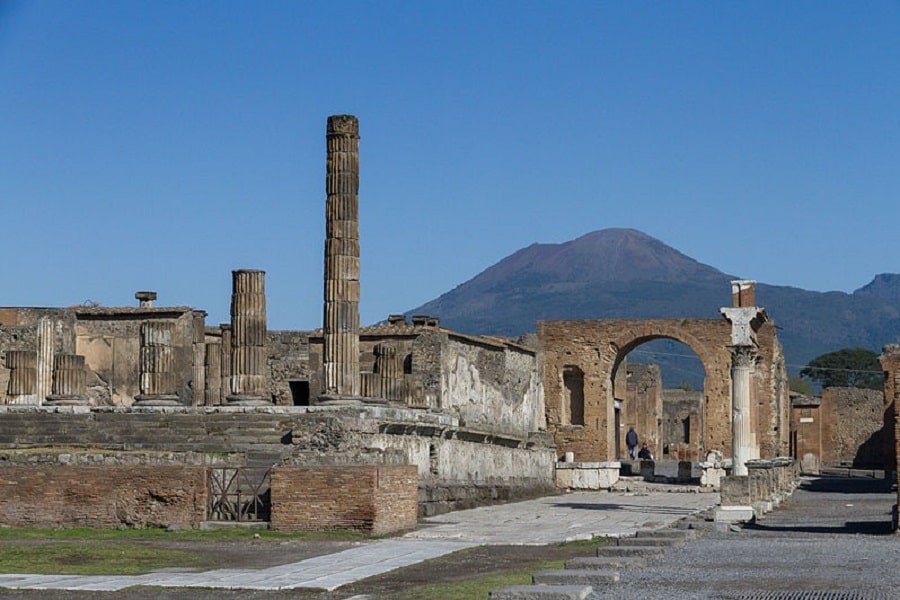
Pompeii, a thriving Roman city located near the Bay of Naples, was tragically engulfed by the eruption of Mount Vesuvius in 79 CE. The volcanic ash and pyroclastic flows swiftly covered the city, preserving its structures and inhabitants in a remarkable state. The city remained hidden for centuries until its accidental rediscovery in 1748, leading to extensive excavations that unearthed a time capsule of ancient Roman life [3].
The extent of the city’s preservation is truly remarkable. Pompeii’s streets, alleyways, and squares are still visible today, offering a vivid representation of an ancient urban center. The buildings that once lined these streets have been revealed, including private houses, public buildings, shops, and temples [7]. The sheer scale of the city, covering an area of 170 acres, showcases the vibrant and bustling nature of Roman urban life.
Rediscovering Pompeii’s Architectural Marvels
Pompeii’s architectural remains are a testament to the advanced engineering and artistic flair of the ancient Romans. The city boasts a wide array of structures, ranging from humble residences to grand public edifices. The houses of Pompeii, such as the House of the Faun and the House of the Vettii, feature beautiful frescoes, intricate mosaics, and well-preserved architectural elements [1]. These houses provide valuable insights into the aesthetics, social hierarchies, and domestic lives of the Pompeian elite.
Public buildings in Pompeii include the Forum, which served as the heart of civic life. The Forum housed administrative buildings, law courts, and markets, serving as a central gathering place for social, political, and commercial activities [3]. The Temple of Jupiter, dedicated to the chief deity of the Roman pantheon, stands as a remarkable example of Roman religious architecture. The Amphitheater of Pompeii, built to host gladiatorial contests and public spectacles, is one of the oldest surviving amphitheaters in the world [3].
READ MORE: The Roman Gladiators: Soldiers and Superheroes
Insights into Pompeii’s Daily Life and Culture
The preserved artifacts and structures of Pompeii offer invaluable glimpses into the daily life and culture of its inhabitants. Walking through the city, one can observe the remnants of bakeries, bars, and shops, providing evidence of a bustling economy and vibrant street life. The Thermopolia, ancient Roman fast-food establishments, reveal the culinary preferences and socializing habits of the Pompeians. Graffiti found on the walls of buildings and in public spaces offer a direct glimpse into the thoughts, concerns, and even political opinions of the ancient residents [7].
Pompeii’s material culture provides a deeper understanding of the lives of its people. The artifacts recovered from the city include pottery, glassware, jewelry, and household items. These objects shed light on the dietary habits, fashion trends, personal adornment, and technological advancements of the time. They also reflect the influence of trade networks and cultural exchanges within the Roman Empire [7].
Moreover, the city’s well-preserved frescoes, mosaics, and sculptures showcase the artistic achievements and decorative tastes of the Pompeians. These artworks depict mythological scenes, daily activities, and portraits, giving us glimpses into their visual culture and aesthetics [1].
Rome: The Eternal City
Rome, often referred to as the Eternal City, stands as a testament to the grandeur and enduring influence of ancient civilizations. From its legendary founding to its status as the capital of the Roman Empire, Rome holds a prominent place in history.
The Colosseum as the Icon of Ancient Rome

The Colosseum, a renowned symbol of ancient Rome, stands as an architectural marvel that attracts history enthusiasts. Built in the 1st century CE, this amphitheater hosted various spectacles, including gladiatorial contests, chariot races, and theatrical performances, captivating the Roman population [7].
The grand structure, featuring intricate arches and tiers, could accommodate approximately 50,000 spectators. The seating arrangements, divided based on social status, mirrored the social hierarchy of ancient Rome, with the elite occupying the lower levels closer to the action.
Delving into the underground chambers, known as the hypogeum, visitors can explore the labyrinth of tunnels where gladiators and wild animals awaited their turn in the arena. The Colosseum’s trapdoors, elevators, and complex system of pulleys and ropes facilitated the dramatic entrance of participants and props, enhancing the theatricality of the events.
The Roman Forum: Heart of Ancient Rome

The Roman Forum, situated in the center of ancient Rome, served as a prominent political, religious, and social hub prominent political, religious, and social hub. It is characterized by the remains of temples, basilicas, and other significant structures that played a pivotal role in shaping the city’s life [7].
Within the Roman Forum, visitors encounter notable landmarks such as the Temple of Saturn, the Arch of Titus, the Basilica Aemilia, and the Temple of Vesta. These structures exemplify the architectural prowess and grandeur of the Roman Empire. The Forum was not only a center of political activities but also a bustling marketplace where traders, merchants, and citizens congregated [5].
The Pantheon: Engineering Marvel of Ancient Rome
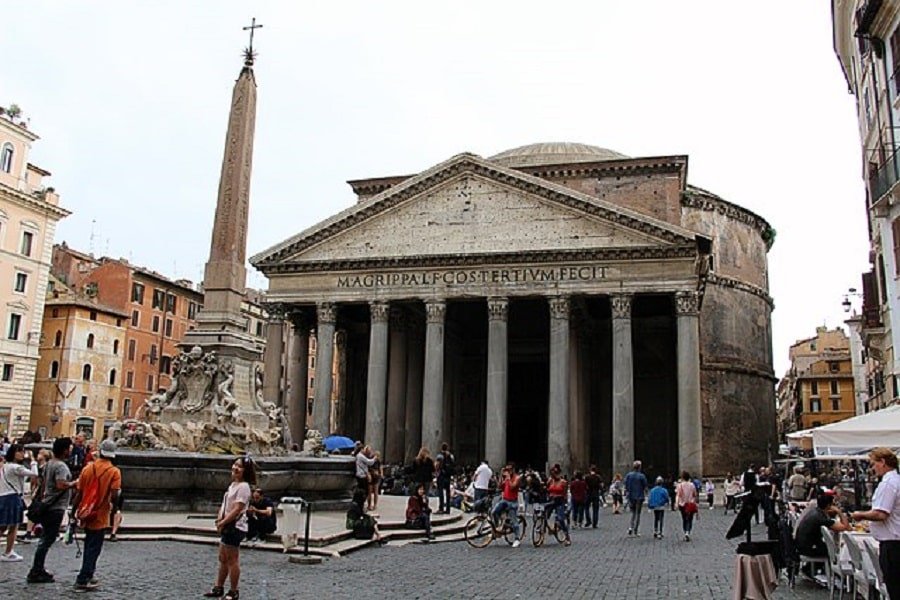
The Pantheon, a remarkable feat of engineering and a testament to Roman architectural prowess stands as one of the best-preserved ancient buildings in the world [4]. Built in the 2nd century CE, this temple-turned-church is dedicated to the Roman gods and goddesses.
As one steps into the Pantheon, one is awestruck by its immense dome, which remains the largest unreinforced concrete dome ever constructed. The oculus, a circular opening at the dome’s apex, allows sunlight to stream into the interior, creating a captivating interplay of light and shadow [1]. The interior of the structure showcases the meticulous craftsmanship and architectural expertise of the Romans, evident in the intricately designed marble floors and the elaborate niches intended for the display of revered deity statues [7].
The Pantheon also serves as the final resting place of several prominent figures, including the artist Raphael. This adds to its cultural and historical significance, further enriching the visitor’s experience [1].
Roman Baths: Centers of Relaxation and Socializing
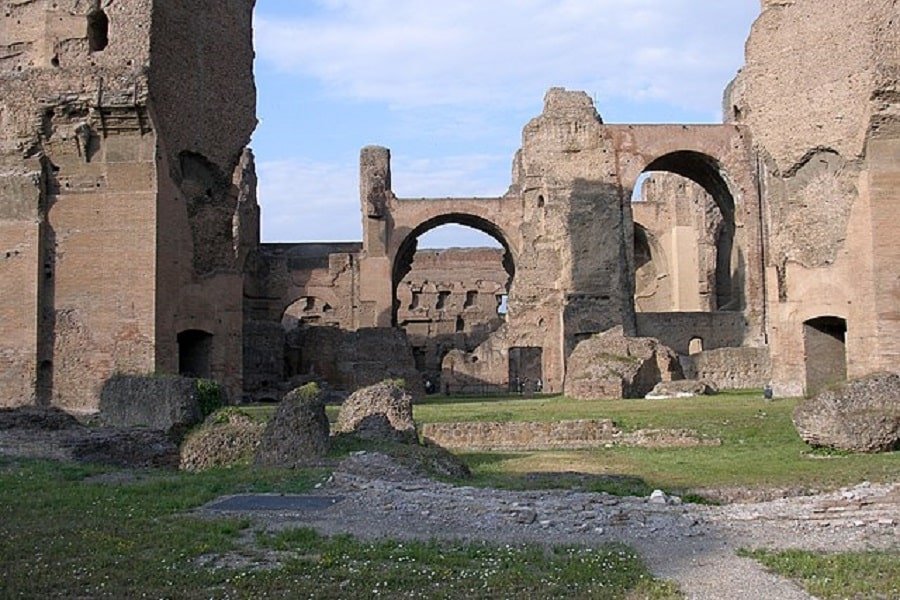
Roman baths played a crucial role in ancient Roman society, serving as places for relaxation, hygiene, and socializing. These grand bath complexes were not only functional but also architectural marvels [4].
The expansive ruins of the Baths of Caracalla and the Baths of Diocletian offer a glimpse into the immense scale and magnificence of these ancient structures. Visitors can marvel at the diverse range of rooms within the baths, which encompassed hot and cold pools, saunas, exercise spaces, and libraries. Lavish embellishments, such as intricate mosaic floors and statues, adorned the bathing chambers, evoking a sense of luxury and grandeur.
Athens: The Birthplace of Democracy
Athens, the ancient Greek city-state, holds a special place in history as the birthplace of democracy and a center for art, philosophy, and intellectual pursuits.
READ MORE: Who Invented Democracy? The True History Behind Democracy
The Acropolis: Symbol of Ancient Athens
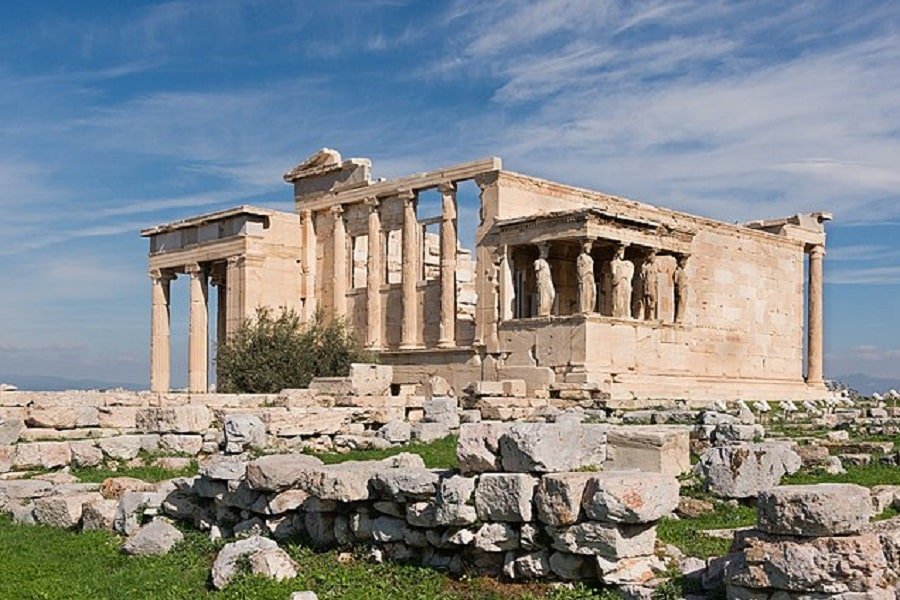
Perched atop a rocky outcrop, the Acropolis stands as a majestic symbol of Ancient Athens. Dominating the skyline, this fortified hilltop sanctuary housed several significant structures that reflected the power and grandeur of the city-state. Among them, the Parthenon reigns supreme [7]. Dedicated to the goddess Athena, the Parthenon showcases the epitome of ancient Greek architecture. Its impressive Doric columns, intricately carved metopes, and pediments depicting mythical narratives all testify to the immense skill and precision of the ancient craftsmen.
The ascent to the Acropolis reveals a series of architectural wonders that continue to captivate. The Erechtheion, notable for its elegant Caryatid statues, stands as a testament to its distinctive design and religious significance. This temple, dedicated to multiple deities, housed the revered olive tree, symbolizing Athena’s gift to the city. Serving as the entrance to the sacred complex, the Propylaea impresses with its imposing scale and serves as a symbol of Athens’ wealth and influence [5].
READ MORE: 41 Greek Gods and Goddesses: Family Tree and Fun Facts
The Agora: Center of Athenian Civic Life
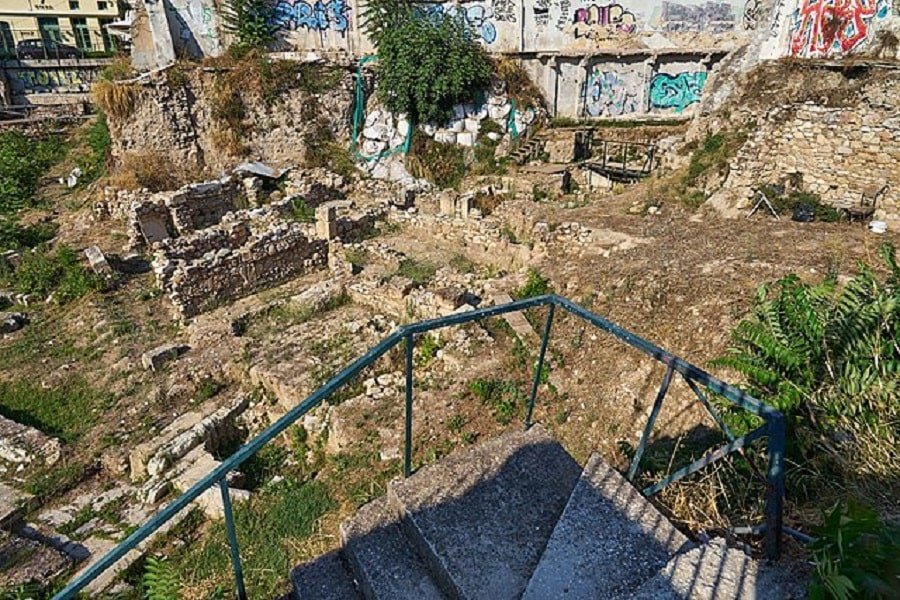
Nestled below the slopes of the Acropolis lies the Agora, the bustling center of Athenian civic life. This open space served as a hub for political, commercial, and social activities. Strolling through the ruins of the Agora, visitors can immerse themselves in the vibrant atmosphere that once prevailed in ancient Athens.
The Stoa of Attalos, a reconstructed ancient covered walkway, offers a glimpse into the daily life and commerce that thrived within the Agora. This stoa, lined with shops, housed various businesses, from pottery and jewelry to food and clothing.
Adjacent to the Stoa of Attalos, the ruins of the Tholos stand as a reminder of the political processes that shaped Athenian governance. This circular building served as the meeting place for the Boule, the council of 500 citizens who played a crucial role in managing the affairs of the city-state [1].
READ MORE: Ancient Greece Timeline: Pre-Mycenaean to the Roman Conquest
Theatre of Dionysus: Birthplace of Greek Drama
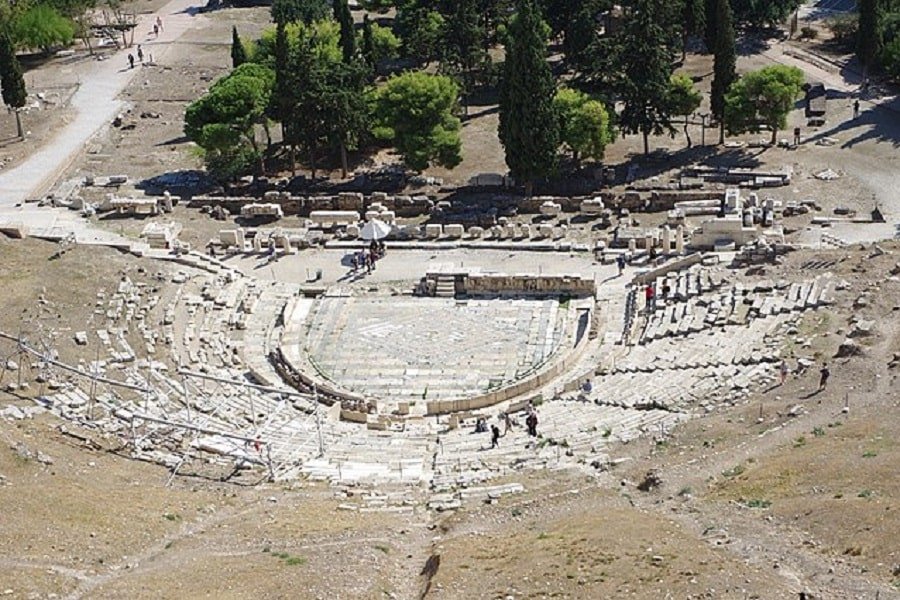
The Theatre of Dionysus, situated at the foot of the Acropolis, holds a special place in the history of theater. It is considered the birthplace of Greek drama [3] and the site where famous playwrights, such as Aeschylus, Sophocles, and Euripides, showcased their masterpieces.
The seating arrangements, divided according to social status, reflect the hierarchical structure of ancient Greek society, with the best seats reserved for the elite [3].
The theater’s well-preserved stage area, stone seating, and impressive backdrop bear witness to its historical significance as the birthplace of Greek theater.
READ MORE: Ancient Greek Art: All Forms and Styles of Art in Ancient Greece
Machu Picchu: Lost City of the Incas

Machu Picchu, known as the “Lost City of the Incas,” is a remarkable archaeological site that continues to captivate scholars and visitors alike. Nestled high in the Andes Mountains at an altitude of around 2,430 meters (7,970 feet) [5], the city remained hidden from the outside world for centuries. It was only in 1911 that Hiram Bingham, an American explorer and archaeologist, rediscovered this extraordinary site.
The ruins of Machu Picchu span an area of approximately 32,500 hectares (80,400 acres) and consist of more than 150 structures, including temples, palaces, houses, and agricultural terraces. The meticulous construction of these structures is a testament to the Inca’s exceptional engineering skills. The stones used in the construction were carved and shaped to fit together with such precision that not even a blade of grass can fit between them. This remarkable stonework has withstood the test of time, remaining intact despite the region’s frequent seismic activity [2].
One of the most intriguing aspects of Machu Picchu is its strategic location. Situated on a ridge between the Huayna Picchu and Machu Picchu mountains, the city offers breathtaking panoramic views of the surrounding valleys and mountains. This strategic positioning suggests that Machu Picchu served both practical and symbolic purposes for the Incas. It may have served as a ceremonial center, a royal retreat, or a place of pilgrimage, where religious and astronomical observations were conducted [2].
Petra: The Rose-Red City
Petra, known as the Rose-Red City, is an ancient Nabatean city located in present-day Jordan. Carved into the pink sandstone cliffs, Petra is a UNESCO World Heritage Site and a testament to the architectural and engineering prowess of the Nabatean civilization.
The Treasury (Al-Khazneh): Iconic Facade of Petra
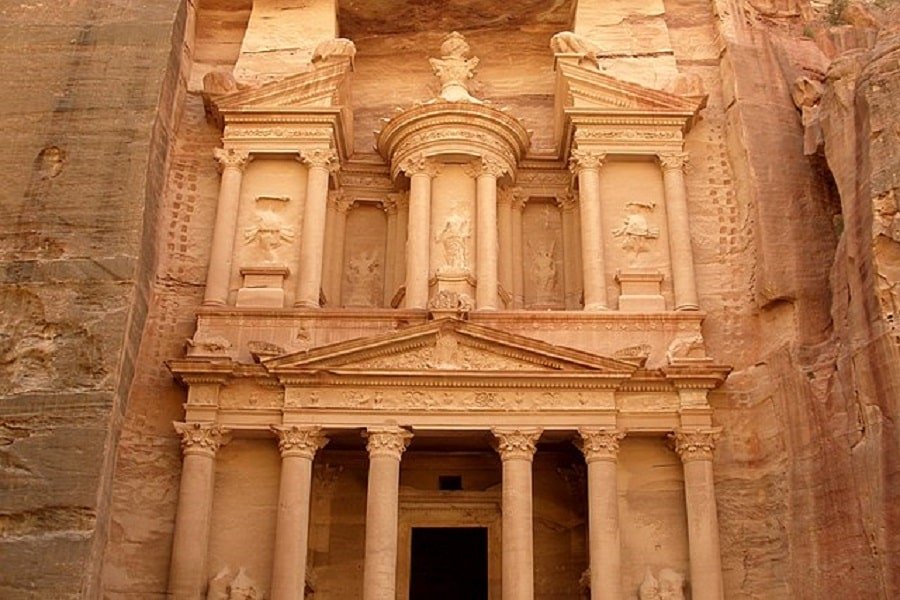
The Treasury, also known as Al-Khazneh, is the most famous and iconic structure in Petra. Carved directly into the sandstone cliffs, it mesmerizes visitors with its impressive facade. Standing at about 40 meters in height, the Treasury features intricate carvings, columns, and a central chamber. Its purpose remains a subject of speculation, with theories ranging from being a royal tomb to a treasury [4].
Approaching the Treasury through the narrow Siq, a natural sandstone gorge, creates a sense of anticipation and wonder. As one emerges from the Siq, the Treasury comes into full view, showcasing its grandeur and blending harmoniously with the surrounding rock formations. The Treasury’s stunning beauty and mysterious aura have made it a symbol of Petra and have captivated the imaginations of travelers and historians alike [4].
The Monastery (Al-Deir): A Majestic Cliff-top Retreat
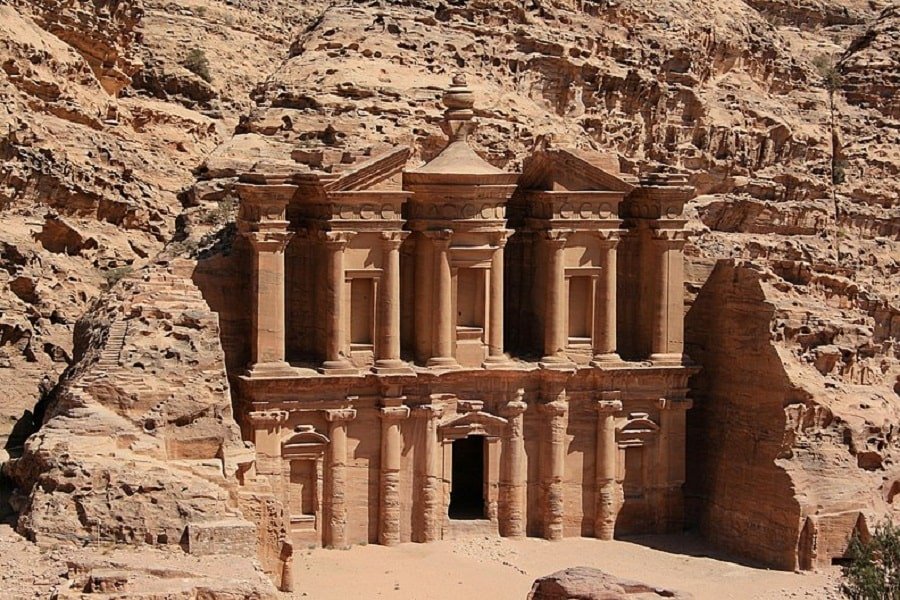
The Monastery, or Al-Deir, is another architectural masterpiece in Petra. It is located high up in the mountains, requiring a challenging climb or a scenic hike to reach it. The Monastery is larger than the Treasury and features a facade adorned with intricate carvings and decorative motifs 4].
Despite its name, the Monastery is believed to have been a temple or a royal tomb, serving as a place of religious or ceremonial significance.
The Siq: Gateway to Petra’s Splendor

The Siq serves as the main entrance to Petra, creating an unforgettable first impression for visitors. This narrow and winding gorge stretches for approximately one kilometer, with towering cliffs on either side, showcasing the geological beauty of the region.
Royal Tombs: Testaments to Nabatean Royalty
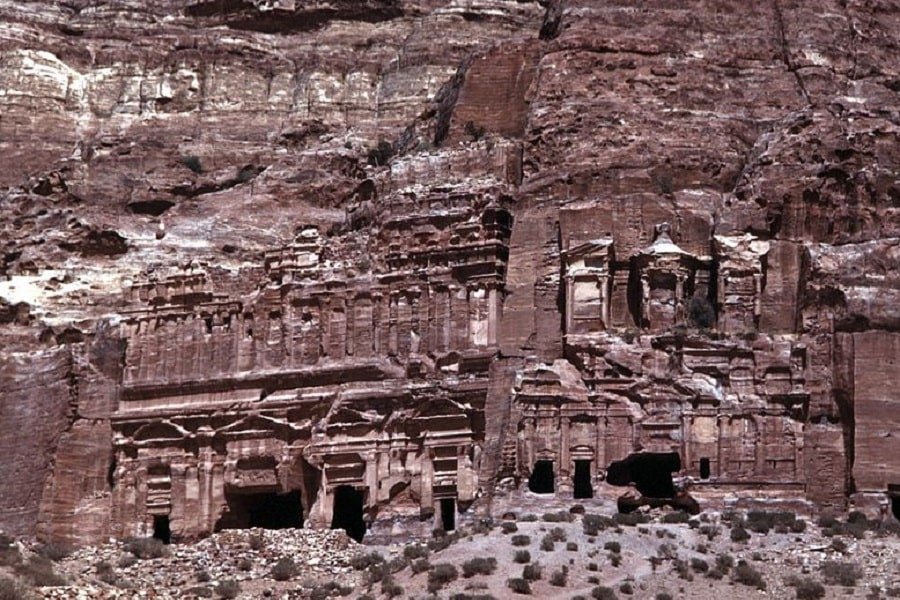
One of the most prominent royal tombs in Petra is the Urn Tomb, named for the large urn-like shape carved into its facade. This tomb features a monumental entrance with classical architectural elements such as columns and pediments. The intricate carvings and ornamental details demonstrate the meticulous craftsmanship of the Nabateans. Inside the tomb, visitors can explore the spacious chambers and gain a sense of the reverence and importance attached to the burial of the Nabatean elite.
Another notable royal tomb is the Silk Tomb, characterized by its vibrant colors and intricate patterns. The name “Silk Tomb” was given due to the fine quality of the rock and its resemblance to the texture of silk. The facade is adorned with beautiful carvings and delicate details, showcasing the artistic prowess of the Nabateans.
The Corinthian Tomb is yet another remarkable example of Nabatean rock-cut architecture. Its facade features Corinthian-style columns and decorative elements, reflecting the influence of Greek and Roman architectural styles on the Nabateans [1].
Angkor Wat: The Majestic Temple Complex

Angkor Wat is a sprawling temple complex located in Siem Reap, Cambodia. It is one of the most significant archaeological sites in Southeast Asia and a UNESCO World Heritage Site. Known for its grandeur, intricate architecture, and religious significance, Angkor Wat is a testament to the ingenuity and artistic achievements of the Khmer Empire.
Angkor Wat is a masterpiece of Khmer architecture, showcasing the extraordinary skills of the ancient builders. The temple complex spans over 400 acres and features intricate carvings, towering spires, and elaborate galleries.
The central structure of Angkor Wat is a massive temple mountain surrounded by a moat, symbolizing the cosmic ocean. It is accessed through a grand causeway, leading to a series of elevated terraces and galleries [4]. The central sanctuary rises to a height of 65 meters, with multiple levels adorned with bas-reliefs depicting Hindu mythology and Khmer historical events.
The intricate carvings at Angkor Wat depict scenes from the Hindu epics, Ramayana and Mahabharata, as well as celestial beings, mythological creatures, and intricate floral motifs. These carvings showcase the Khmer Empire’s devotion to religious beliefs and their mastery of stone carving techniques [2].
One example of the intricate carvings is the famous Churning of the Ocean of Milk bas-relief [2]. This massive panel, located in the eastern gallery, depicts the Hindu mythological story of gods and demons churning the cosmic ocean to extract the elixir of immortality. The level of detail and the sheer scale of this bas-relief is astounding, with hundreds of figures intricately carved into the sandstone.
READ MORE: The 10 Most Important Hindu Gods and Goddesses
Mohenjo-Daro
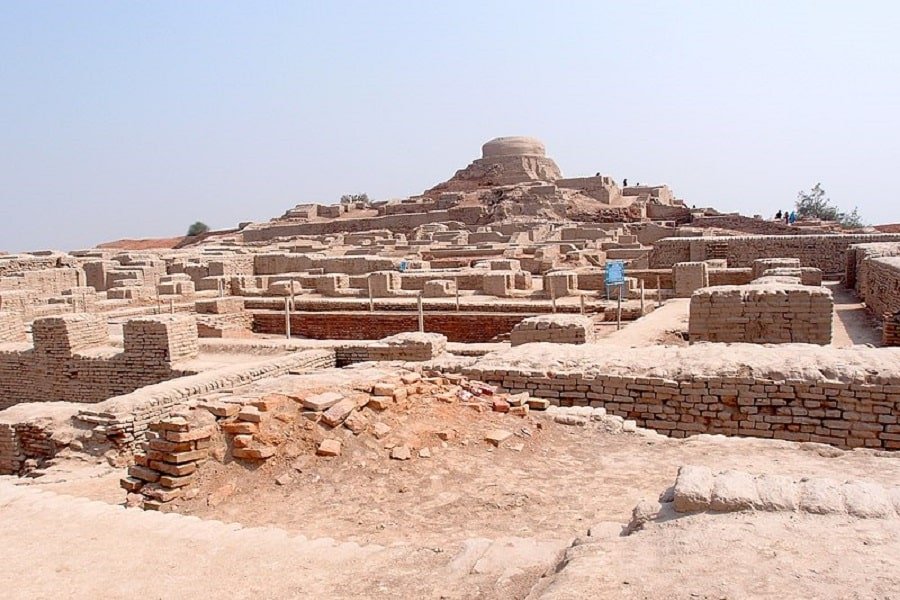
Mohenjo-Daro’s meticulously planned urban design showcases the remarkable engineering and architectural skills of its inhabitants. The city was built on a grid system with well-defined streets and organized blocks. The streets were constructed with a slope to facilitate drainage and were lined with houses, creating a sense of order and functionality. One notable example is the Great Bath, a large public water tank built with tightly fitted bricks and a sophisticated water management system, indicating the importance of communal bathing and possibly religious rituals [8].
READ MORE: Who Invented Water? History of the Water Molecule
Excavations have revealed the remains of public buildings, including the Great Hall and the Assembly Hall, suggesting a system of governance and administration. Private houses with courtyards, granaries for storing grain, and marketplaces indicate a complex economic and social structure. Artifacts such as seals with Indus script and figurines provide clues about their writing system, religion, and cultural practices [8].
Ephesus (Turkey): A Timeless Marvel
Ephesus, located in present-day Turkey, is an ancient city that played a significant role in both Greek and Roman history. It boasts a rich cultural and architectural heritage, with numerous remarkable structures that have captivated visitors for centuries.
The Library of Celsus: Where Knowledge Breathes

One of the most iconic structures in Ephesus is the Library of Celsus. This magnificent library, named after the Roman senator Gaius Julius Celsus Polemaeanus, showcases the exceptional architectural skills of the time. The library’s facade, meticulously decorated with statues and intricate reliefs, is a testament to the grandeur and artistic prowess of the ancient builders. It stood as a symbol of intellectualism and learning, housing thousands of scrolls and attracting scholars from far and wide [2].
For example, the facade of the Library of Celsus is adorned with statues representing Wisdom, Knowledge, Intelligence, and Valor, emphasizing the importance of education and wisdom in ancient Ephesus. The intricate carvings depict mythological figures, historical events, and scenes from daily life, providing insights into the cultural and intellectual milieu of the city.
The Great Theater: Echoes of Spectacle

The Great Theater of Ephesus is another architectural marvel that leaves visitors in awe. This massive theater, capable of accommodating approximately 25,000 spectators, stands as a testament to the advanced engineering and design skills of the ancient Ephesians [5]. The theater was not only a venue for theatrical performances but also hosted political assemblies, religious ceremonies, and musical concerts.
One notable feature of the theater is its remarkable acoustics. Even from the highest tiers, a speaker’s voice could be heard clearly throughout the entire theater.
The Temple of Artemis: Majestic Shrine of the Divine
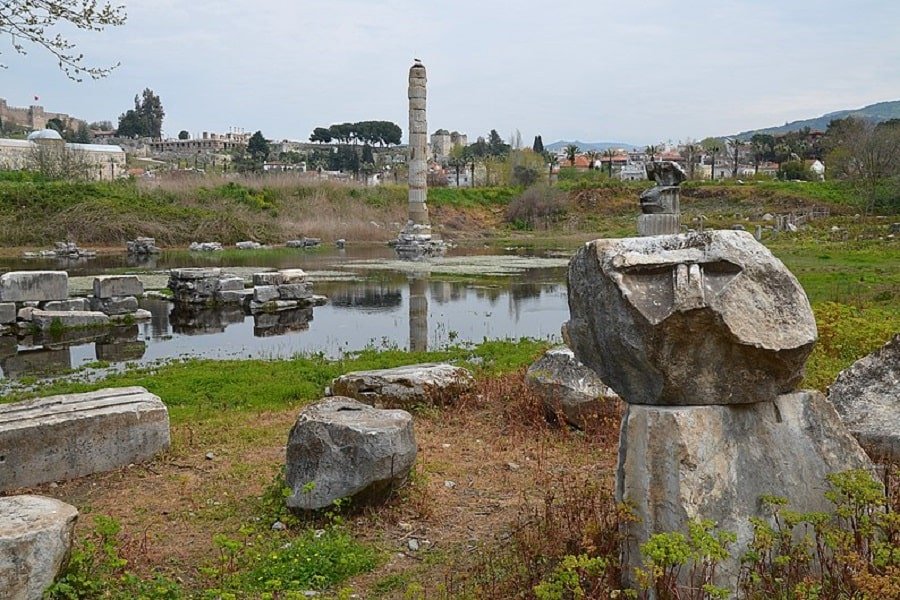
The Temple of Artemis, dedicated to the Greek goddess Artemis, was one of the most revered religious sanctuaries in the ancient world. It was renowned for its grandeur and size, attracting pilgrims and visitors from near and far [2]. The temple’s architectural design, featuring numerous columns and intricate sculptures, exemplified the craftsmanship and devotion of the ancient Ephesians. Unfortunately, only fragments of the Temple of Artemis remain today.
The Temple of Artemis was believed to house a sacred statue of the goddess, which was considered a symbol of power and protection. Its construction and embellishments were funded by wealthy individuals, city-states, and rulers who sought to demonstrate their piety and gain favor with the goddess.
Teotihuacan (Mexico): Unraveling the Mysteries of the Gods
Teotihuacan, located in present-day Mexico, is an ancient city that flourished from around 100 BCE to 550 CE. Known as the “City of the Gods,” it was one of the most influential and largest pre-Columbian cities in the Americas.
READ MORE: Who Discovered America: The First People Who Reached the Americas
Pyramid of the Sun: Ascending to Celestial Heights
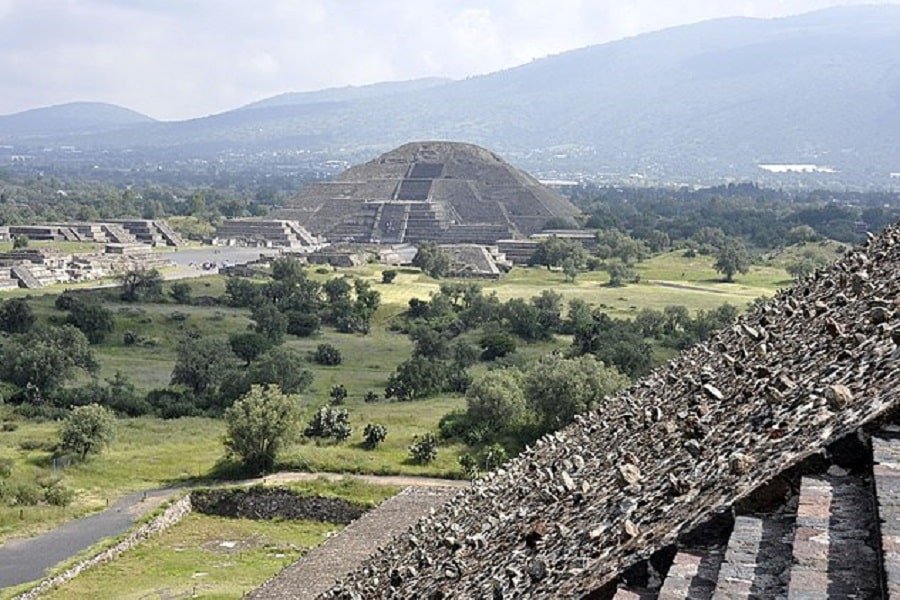
The Pyramid of the Sun is a colossal structure that dominates the Teotihuacan landscape. Its impressive size and intricate construction highlight the advanced engineering skills of the ancient Teotihuacanos [2]. The pyramid’s base covers an area of approximately 225,000 square meters (2.4 million square feet), and its height reaches over 60 meters (200 feet).
For example, the construction of the Pyramid of the Sun required the transportation of massive stone blocks from distant quarries. The builders carefully aligned the pyramid with the cardinal directions, incorporating astronomical alignments into its design. The significance of the pyramid is evident in the elaborate rituals and ceremonies that took place at its summit, symbolizing the connection between the heavens and the earthly realm.
READ MORE: Pyramids in America: North, Central, and South American Monuments
Pyramid of the Moon: Gateway to the Divine
The Pyramid of the Moon is another impressive structure in Teotihuacan, situated at the northern end of the city’s main avenue. It is characterized by its stepped architecture and intricate ornamentation. The pyramid’s position, overlooking the Avenue of the Dead, gives it a commanding presence within the city’s layout [4].
For instance, the Pyramid of the Moon was intricately linked to the cycles of the moon and its connection to fertility and agricultural prosperity. Its construction and alignment reflect the ancient Teotihuacanos’ deep understanding of celestial movements and their reverence for natural forces.
Avenue of the Dead: A Path to Mystery
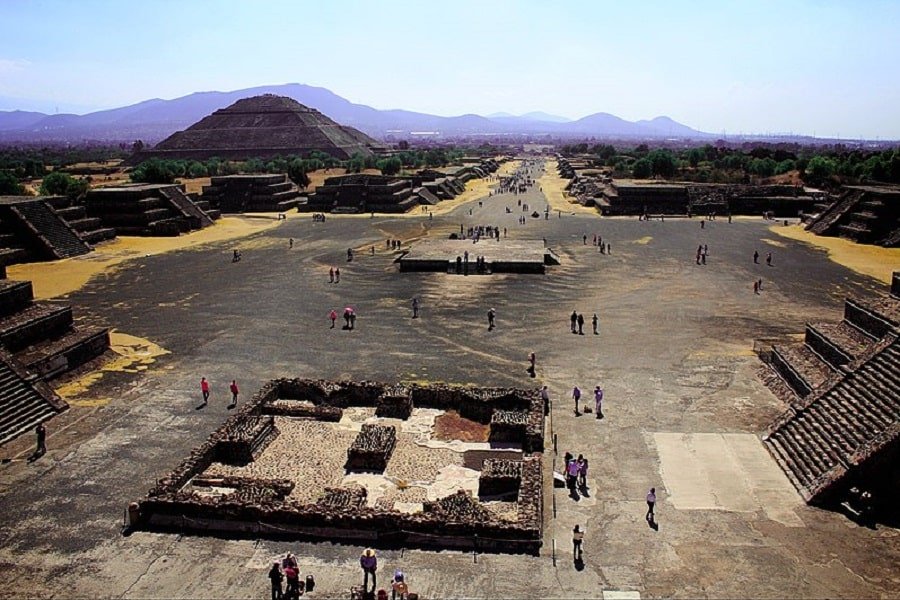
The Avenue of the Dead is a monumental thoroughfare that cuts through the heart of Teotihuacan. Stretching over 2 kilometers (1.2 miles), it connects various architectural complexes, including temples, palaces, and residential areas. The avenue served as a vibrant ceremonial and processional route during the city’s peak [4].
For example, the Temple of the Feathered Serpent, also known as the Pyramid of Quetzalcoatl, stands along the Avenue of the Dead [4]. This temple is adorned with intricate stone carvings depicting feathered serpents, warriors, and other mythological figures.
READ MORE: The 23 Most Important Aztec Gods and Goddesses
Palmyra: A Historical Gem in the Syrian Desert
Palmyra, located in present-day Syria, was an ancient city that served as a significant crossroads of trade and culture in the ancient world. It flourished during the Roman period and is renowned for its well-preserved ruins, which offer insights into the city’s rich history and architectural achievements.
Grand Colonnades: Iconic Remnants of Palmyra’s Splendor

One of the most striking features of Palmyra is its grand colonnades, which served as the city’s main thoroughfares [2]. These majestic avenues, lined with rows of towering columns, stretched across the city, creating an awe-inspiring visual spectacle. The colonnades reflect the city’s prosperity and its importance as a vibrant trading hub.
For example, the Great Colonnade, the city’s main street, spanned over one kilometer in length and was adorned with intricately carved Corinthian columns.
Temple of Bel: A Sacred Sanctuary of Palmyrene Spirituality
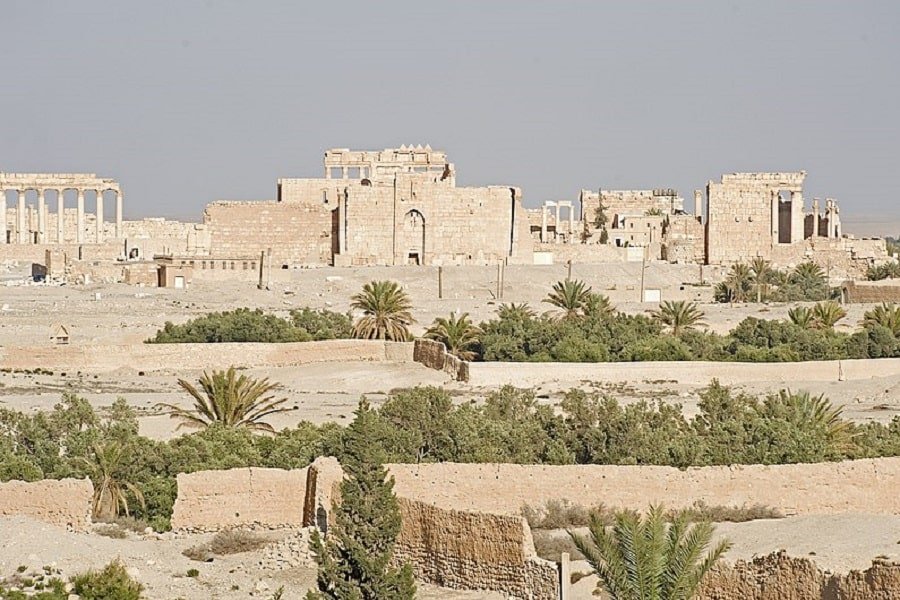
The Temple of Bel, dedicated to the Semitic god Bel, was one of the most significant religious structures in Palmyra. It stood as a symbol of the city’s religious and cultural identity [2]. This immense temple complex boasted impressive architectural features, including a grand entrance, a central sanctuary, and courtyards adorned with statues and reliefs.
An example of the Temple of Bel’s architectural splendor is its towering main cella, or inner sanctuary, which housed a cult image of Bel. The surrounding courtyards served as spaces for rituals and gatherings, and they were adorned with elaborate carvings and inscriptions depicting scenes from ancient myths and legends. These artistic depictions provide valuable insights into the religious beliefs and practices of the people of Palmyra [2].
Arch of Palmyra: A Triumphal Monument to Palmyra’s Greatness

The Arch of Palmyra, also known as the Monumental Arch, is an iconic symbol of the city’s rich history and architectural splendor. This monumental triumphal arch served as an entrance gate to the city and was built to commemorate military victories. It stood as a testament to the grandeur and importance of Palmyra [2].
An example of the Arch of Palmyra’s significance is its elaborate sculptural decorations. The arch features depictions of scenes of conquest, mythological figures, and symbolic motifs. Its intricately carved details, including floral patterns, military imagery, and inscriptions, showcase the artistic craftsmanship of the time and provide valuable historical and cultural references [5].
It is worth noting that the Arch of Palmyra gained international attention in recent years due to the tragic destruction caused by conflicts in the region. However, efforts are underway to preserve and reconstruct this cultural heritage site as a symbol of resilience and a reminder of the importance of safeguarding the world’s ancient treasures [5].
Tikal: Ancient Splendors Amidst Guatemalan Jungles
Tikal, located in the dense jungles of Guatemala, was one of the most powerful and influential ancient cities of the Maya civilization. It reached its peak during the Classic Period (250-900 CE) and played a significant role in the political, economic, and cultural landscape of the region.
Temple I (Temple of the Great Jaguar)
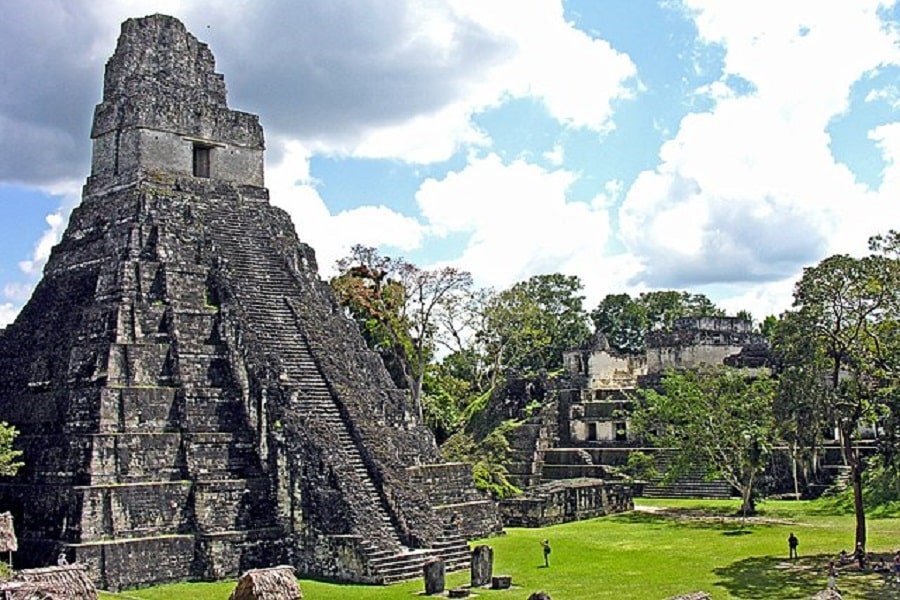
Temple I, also known as the Temple of the Great Jaguar, is one of the most iconic structures in Tikal. This towering pyramid-shaped temple rises above the jungle canopy and serves as a testament to the architectural and engineering skills of the Maya civilization [6].
For example, Temple I reaches a height of over 47 meters (154 feet) and consists of multiple terraces and staircases leading to its summit. It was built as a funerary temple, housing the tomb of a powerful ruler.
Temple II (Temple of the Masks)
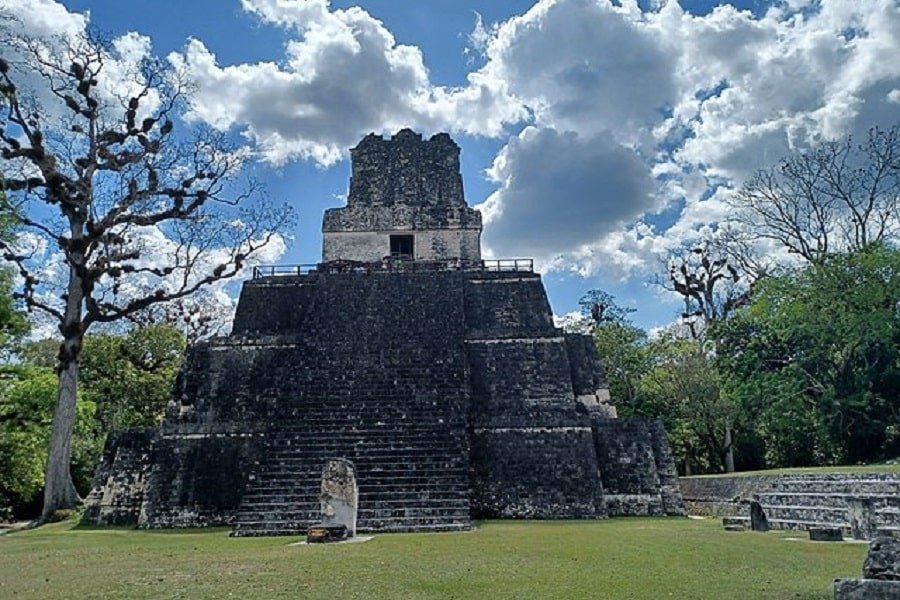
Temple II, also known as the Temple of the Masks, is another notable structure in Tikal. Situated on the opposite side of the Great Plaza from Temple I, it forms a significant architectural and visual complex within the ancient city.
An example of the Temple of the Masks’ distinctive features is its multiple masks carved into the facade, representing the Maya sun god. These masks, with their intricate details and symbolism, showcase the artistic and religious prowess of the Maya civilization [6]. The temple’s elevated platform offers panoramic views of the surrounding landscape and serves as a prominent vantage point for observing ceremonial activities and the city’s expansive layout.
The Great Plaza: Gathering Place of Tikal’s Social and Political Life
The plaza served as a venue for various ceremonies, rituals, and public events, reflecting the vibrant social fabric of Tikal’s inhabitants.
For instance, the Great Plaza features stelae, tall stone monuments adorned with intricate carvings and hieroglyphic inscriptions. These stelae commemorate important historical events, royal lineages, and divine connections. They provide invaluable historical and cultural information about Tikal’s rulers, political alliances, and religious practices.
Additionally, the Great Plaza is flanked by other significant structures, such as palaces, ball courts, and temples, which highlight the city’s architectural grandeur and organizational complexity [6].
Carthage (Tunisia)
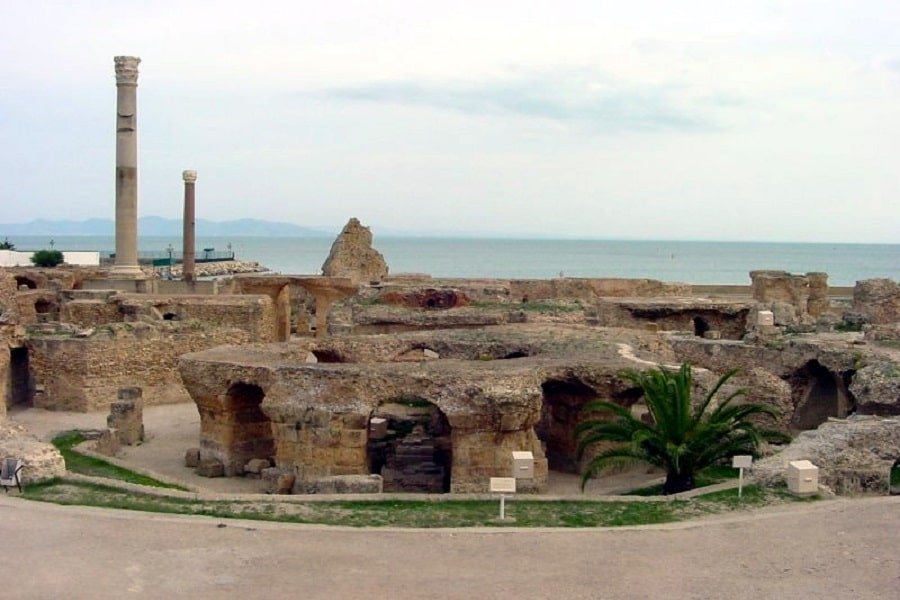
Carthage, located on the coast of modern-day Tunisia, was once a powerful ancient city and a major center of trade and influence in the Mediterranean region. Established by the Phoenicians and later conquered by the Romans, Carthage boasts a rich history and architectural heritage.
Roman Villas: Luxurious Residences of Carthage’s Elite
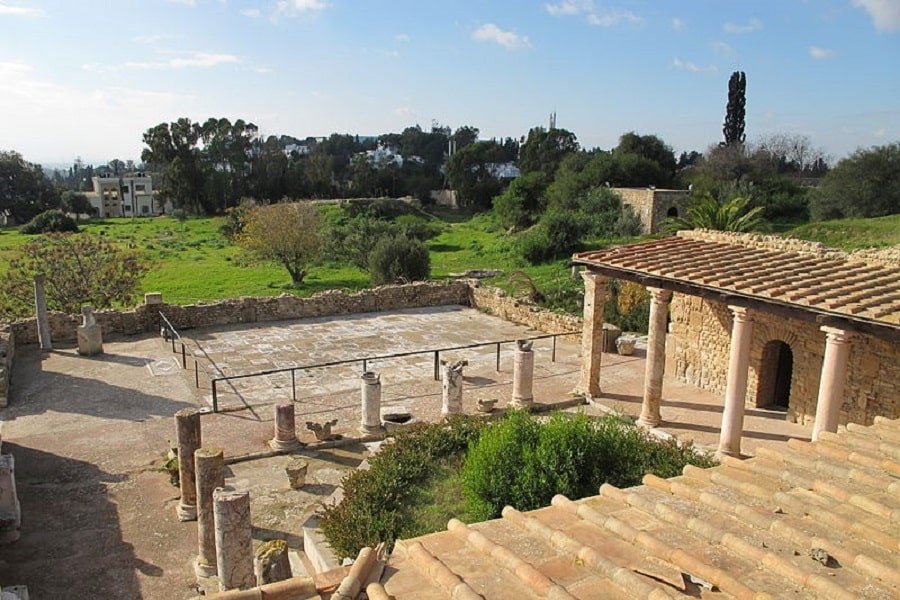
Carthage is known for its impressive Roman villas, which provide insights into the opulent lifestyle and cultural influences of the Roman elite. One notable example is the Villa of the Antonines, also known as the Villa of the Africanus [1]. This expansive complex showcases exquisite mosaic floors, intricate frescoes, and beautifully landscaped gardens. The Villa of the Antonines was a luxurious residence with multiple courtyards, private rooms, and public spaces adorned with ornate decorations. These villas served as symbols of wealth, power, and refined taste, showcasing the influence of Roman culture on Carthaginian society [3].
Antonine Baths
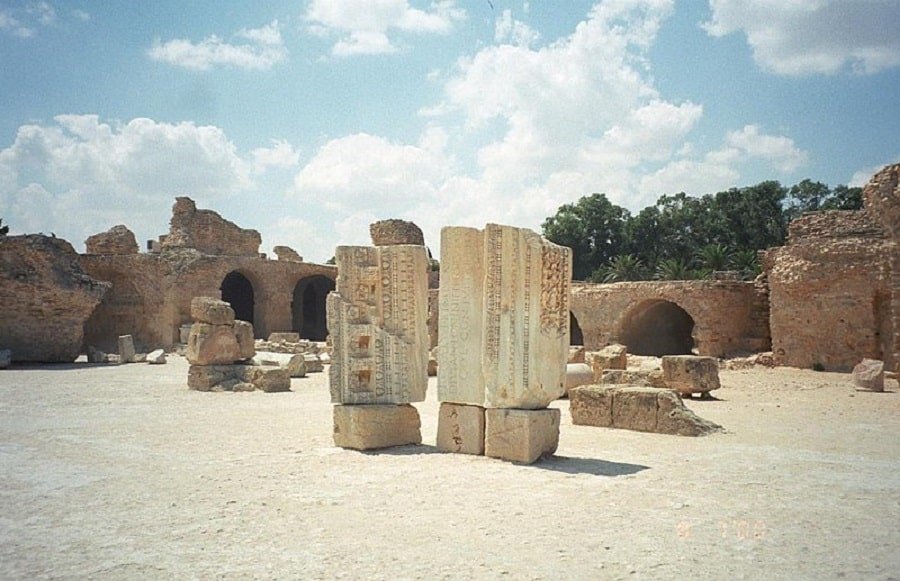
The Antonine Baths in Carthage stand as a testament to the city’s advanced engineering and architectural achievements. Built during the reign of Emperor Antoninus Pius in the 2nd century CE, these baths were a place of relaxation, cleanliness, and socializing. The baths featured a series of interconnected rooms, including a frigidarium (cold room), tepidarium (warm room), and caldarium (hot room) [1], each equipped with pools and heating systems. The frigidarium, the central hall of the baths, showcased a large cold-water pool surrounded by ornate columns and decorative elements.
Defensive Walls
The defensive walls of Carthage played a crucial role in protecting the city and its inhabitants. These fortifications were designed to withstand sieges and attacks, reflecting the strategic importance of Carthage as a regional power [2]. The walls of Carthage encompassed a significant portion of the city and were constructed using various materials, including stone and earthworks. They featured gates, watchtowers, and battlements, ensuring both defensive capabilities and a sense of grandeur.
One notable example is Byrsa Hill, where the ancient citadel of Carthage stood. It was fortified with walls and served as a stronghold during conflicts [4].
References
- Gates, C. (2003). Ancient Cities: The Archaeology of Urban Life in the Ancient Near East and Egypt, Greece and Rome.
- Smith, M. L. (2019). Cities: The First 6,000 Years.
- Coulanges, F. de. (1980). The Ancient City: A Study on the Religion, Laws, and Institutions of Greece and Rome.
- Golvin, J. C. (2007). Ancient Cities Brought to Life.
- McEvedy, C. (2011). Cities of the Classical World: An Atlas and Gazetteer of 120 Centres of Ancient Civilization.
- Culbert, T. P. (1988). Ancient Cities: The Archaeology of Urbanism in Lowland Maya Civilization.
- Connolly, P. (1998). The Ancient City: Life in Classical Athens and Rome.
- Charles River Editors. (2016). Mohenjo-daro: The History and Legacy of the Ancient Settlement of the Indus Valley Civilization.